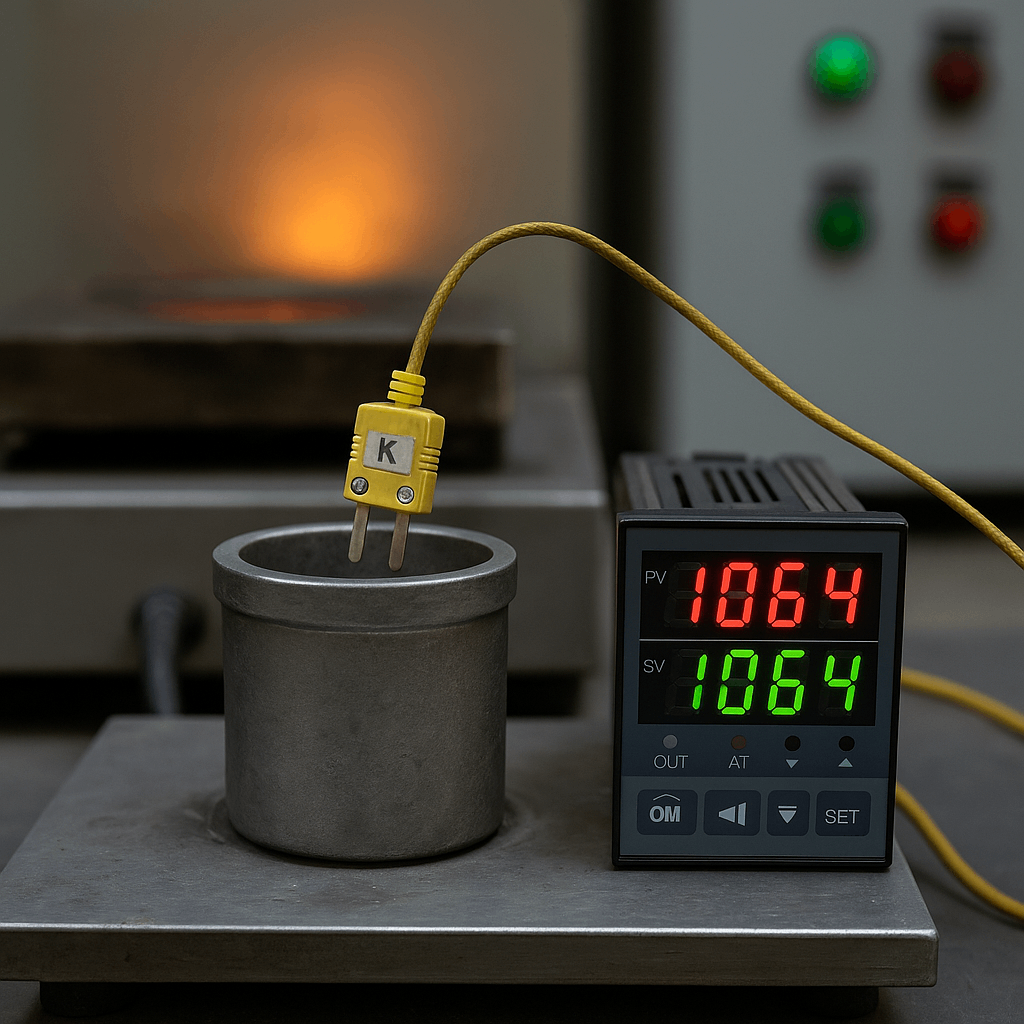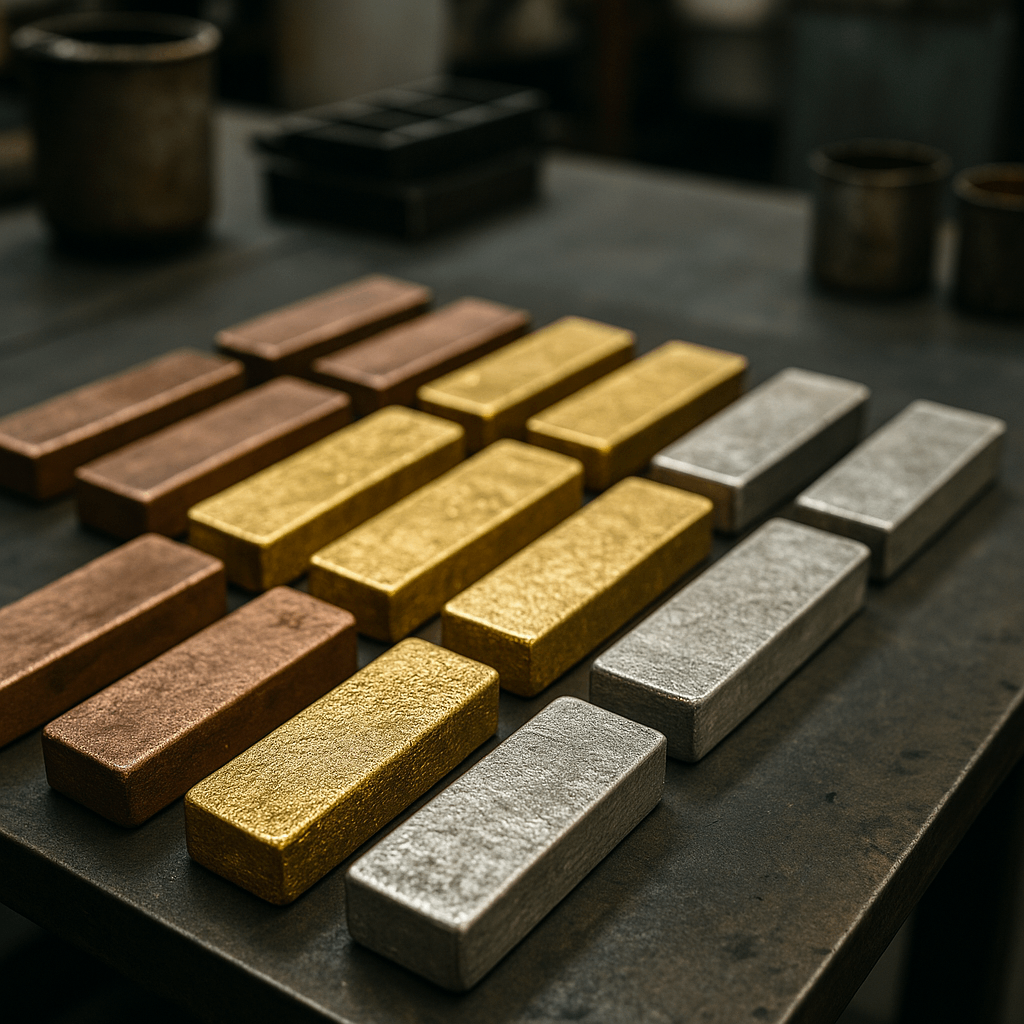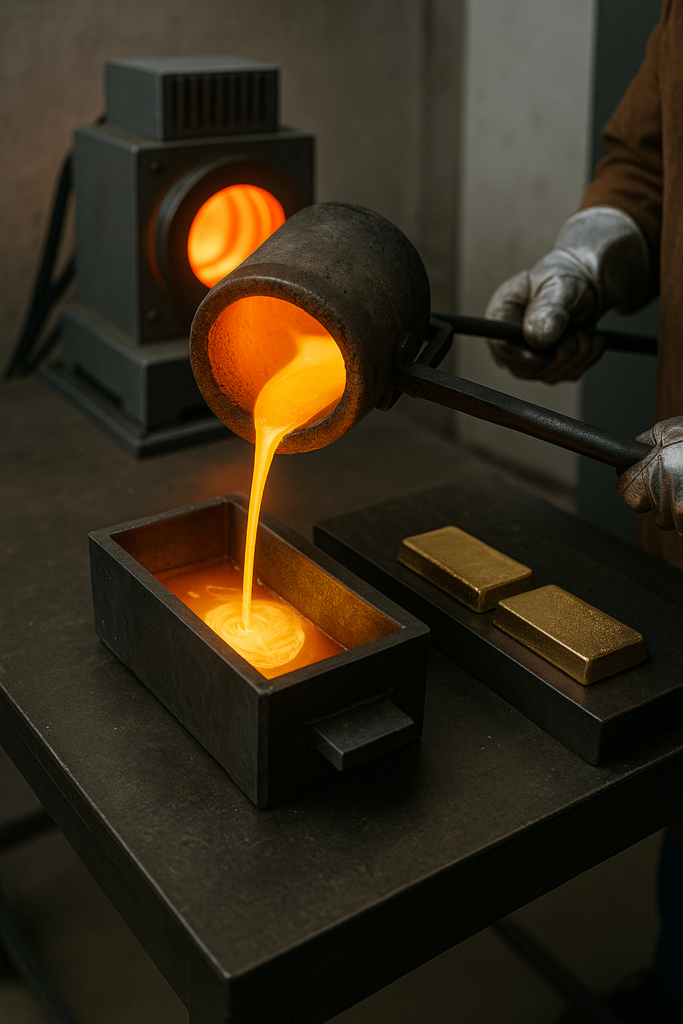For professionals in manufacturing, electronics, and precious metals procurement, gold’s value extends far beyond its market price. Its utility is defined by a set of predictable, reliable physical properties, chief among them being the melting point of gold.
This critical temperature dictates how the metal is refined, alloyed, and fabricated into everything from high-reliability electronic components to investment-grade bullion.
This guide offers a definitive, B2B-focused exploration of gold’s melting temperature. Beyond the number itself, we examine the physics behind its stability, the processing variables that matter in industry, and the real-world applications that impact purchasing and fabrication. Whether you’re looking to optimize your industrial gold melting process or source gold alloys for CNC fabrication, this resource covers every key angle.
The 1064°C Standard: The Benchmark for Quality and Calibration
For immediate reference, the melting point of pure gold is a globally recognized constant: 1,064.18°C (1,947.52°F). This is the precise temperature at which 24-karat gold transitions from a solid to a liquid state under standard atmospheric pressure.
This value is not just a figure in a textbook—it is foundational to international metrology. The freezing point of gold is so consistent that it serves as a key reference point in the International Temperature Scale of 1990 (ITS-90).
National metrology institutes such as NIST use this constant to calibrate high-temperature measurement instruments, ensuring uniformity in thermal specifications throughout global industries. For procurement professionals, this reflects the material’s exceptional stability and reliability and serves as a critical benchmark in the gold melting point for manufacturing.

The Einstein in the Ingot: The Physics Driving Gold's Performance
Gold’s thermal stability, particularly its high melting point, stems from its unique atomic characteristics—an insight supported by Albert Einstein’s theory of special relativity.

The "Sea of Electrons" and Metallic Bonds
In gold, atoms are bound by strong metallic bonds. Each atom donates its outer electron to a shared, delocalized electron cloud, creating a stable lattice through electrostatic attraction between positively charged atomic cores and the negative electron sea.
When heated, energy causes atoms to vibrate more intensely. At the melting point, this vibration disrupts the crystal lattice enough to allow fluid movement. Notably, these metallic bonds are weakened, not broken—complete bond dissociation only occurs at the much higher boiling point of 2,856°C, which explains gold’s resilience in high-heat applications such as circuit assembly and thermal bonding.
The Relativistic Secret: Why Gold Outperforms Silver
Although silver (961.8°C) is adjacent to gold on the periodic table, gold’s melting point is notably higher—a difference explained by relativistic effects.
Gold’s large nucleus (79 protons) causes inner electrons to travel at relativistic speeds, increasing their effective mass. This contracts the 6s orbital toward the nucleus (a phenomenon called relativistic contraction), strengthening gold’s metallic bonds.
For manufacturers, this translates into greater thermal endurance. Gold’s enhanced bond strength—derived from relativity—is precisely why it performs better than silver under heat stress in critical applications such as high-temperature gold melting for electronics production.
The Malleable Constant: Factors That Impact Gold's Melting Point in Manufacturing
While 1,064.18°C is the standard for pure gold, real-world manufacturing involves conditions and compositions that can shift this melting behavior. Understanding these factors is essential for process consistency and performance.
Factor 1: Alloying (The Karat System)
Pure gold is often alloyed with metals like copper or palladium to increase strength. This alloying introduces disruptions in the crystal lattice, lowering cohesive energy and thereby reducing the melting point.
For example, 14K yellow gold melts at around 879°C—allowing energy-efficient production and enabling advanced techniques like soldering. This trade-off between durability and thermal behavior is crucial in both jewelry and industrial manufacturing and explains the wide melting point range of gold alloys in production settings.

Factor 2: Pressure
Under high-pressure conditions, gold’s melting point rises. Because solid gold is denser than liquid gold, increased pressure favors the solid phase.
This is particularly relevant in specialized manufacturing where materials are subjected to compression. Engineers must account for this when setting thermal parameters, especially when designing industrial gold melting systems.
Factor 3: Nanoscale (The Size Effect)
At the nanoscale, gold behaves differently. Melting-point depression means that gold nanoparticles—due to their high surface-area-to-volume ratio—melt at much lower temperatures.
Particles just 2–3 nanometers in size can melt below 600°C. This is vital for sectors like electronics, where gold is used in sensors, and in medicine for targeted delivery applications. Understanding gold melting behavior at the nanoscale is key for companies producing high-precision gold components.

Factor 4: Chemical Environment
Furnace atmosphere matters. While gold resists oxidation, alloying elements may not. Oxidation can introduce impurities during melting.
To maintain material integrity, melting is often done in vacuum chambers or with inert gases like argon, especially in high-spec applications such as custom gold alloy melting for medical equipment.
Factor 5: Structural Defects
Real-world gold contains imperfections—grain boundaries, vacancies, and dislocations—that are weak points in the lattice.
Melting typically begins at these locations, sometimes at lower temperatures than expected. Sourcing well-processed materials with uniform grain structures helps ensure predictable performance during heating in any industrial gold smelting process.
Gold in the Workshop: A Professional's Guide to Melting
Melting gold in a professional setting demands precision. The choice of equipment and techniques directly affects efficiency, purity, and cost control.

Choosing Your Heat Source: Induction vs. Torch
Induction Furnaces: Ideal for industrial-scale operations. They deliver clean, efficient heating with precise control. The electromagnetic process targets the metal itself, reducing waste and enhancing safety.
Oxy-acetylene/Propane Torches: Best for small-scale tasks like jewelry repairs. While effective, they lack the precision and repeatability needed for high-volume industrial use, particularly in gold melting for CNC fabrication or mass casting.
The Essential Toolkit
Professionals rely on high-quality tools:
Graphite Crucibles: Resistant to high temperatures and chemically inert, preventing contamination.
Heat-Resistant Tongs: Enable safe handling of molten gold.
Pre-heated Molds: Prevent thermal shock and ensure casting integrity.
Safety Gear: Mandatory protection includes gloves, face shields, aprons, and proper ventilation.
The Critical Role of Flux (Borax)
Flux is indispensable. Borax, the industry standard, serves multiple roles:
Purity: Removes non-metallic impurities through slag formation.
Yield: Prevents oxidation and minimizes material loss.
Equipment Care: Protects crucibles by forming a barrier that reduces sticking and wear.
Using the right flux is essential to maintaining product consistency in any controlled gold melting process.
Data for Design & Fabrication: Gold by the Numbers
Access to accurate data is essential for engineers, designers, and procurement teams. These tables offer quick-reference material specifications.
Melting Ranges of Commercial Gold Alloys
Use this data to select alloys that meet your performance and processing needs:
| Karat Purity | Common Use | Melting Range (°C) | Melting Range (°F) |
|---|---|---|---|
| 24K (Fine Gold) | Investment Bars, High-End Electronics | 1,064°C | 1,947°F |
| 22K Yellow Gold | Coinage, Jewelry | ~995–1,020°C | ~1,823–1,868°F |
| 18K Yellow Gold | Fine Jewelry | ~890–926°C | ~1,634–1,700°F |
| 14K Yellow Gold | Standard Jewelry | ~820–879°C | ~1,508–1,615°F |
| 18K White Gold | Fine Jewelry | ~950–990°C | ~1,742–1,814°F |
These ranges are essential for anyone working with gold alloys in manufacturing, particularly when selecting the right temperature for gold smelting applications.
Gold vs. Key Industrial Metals
This comparison helps contextualize gold’s performance in thermal applications:
| Metal | Melting Point (°C) | Why It Differs from Gold |
| Silver (Ag) | 961.8°C | Less bond strength; no relativistic contraction. |
| Gold (Au) | 1,064.18°C | Enhanced bonding from relativistic effects. |
| Copper (Cu) | 1,085°C | Similar standard metallic bonding to gold, resulting in a close value. |
| Platinum (Pt) | 1,768.3°C | Stronger bonds due to d-orbital electron participation. |
| Tungsten (W) | 3,422°C | Extremely strong covalent bonds from multiple d-electrons. |
Conclusion: From a Physical Constant to an Industrial Tool
Gold’s melting point is more than a static figure—it embodies a blend of fundamental physics and practical relevance.
For professionals sourcing or working with performance metals, understanding what influences this thermal behavior leads to better material choices, tighter process control, and improved outcomes.
At YISHANG, we bring decades of experience in metal processing and customization. If you’re evaluating gold or its alloys for your next project—whether it’s gold melting for CNC fabrication, precision smelting, or alloy sourcing—our team is ready to support you with expert insights and tailored solutions.

